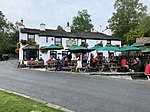Little Langdale
Hamlets in CumbriaNational Trust properties in the Lake DistrictReservoirs in CumbriaSites of Special Scientific Interest in CumbriaSouth Lakeland District ... and 1 more
Valleys of Cumbria

Little Langdale is a valley in the Lake District, England, containing Little Langdale Tarn and a hamlet also called Little Langdale. A second tarn, Blea Tarn, is in a hanging valley between Little Langdale and the larger Great Langdale to the north. Little Langdale is flanked on the south and southwest by Wetherlam and Swirl How, and to the north and northwest by Lingmoor Fell and Pike of Blisco. The valley descends to join with Great Langdale above Elter Water.
Excerpt from the Wikipedia article Little Langdale (License: CC BY-SA 3.0, Authors, Images).Little Langdale
Geographical coordinates (GPS) Address Nearby Places Show on map
Geographical coordinates (GPS)
| Latitude | Longitude |
|---|---|
| N 54.421 ° | E -3.056 ° |
Address
LA22 9PB , Lakes
England, United Kingdom
Open on Google Maps











